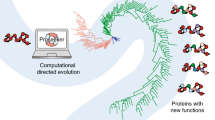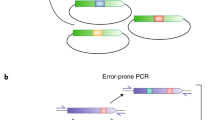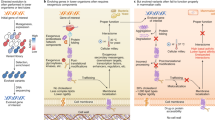Abstract
The pre-RNA world hypothesis postulates that RNA was preceded in the evolution of life by a simpler genetic material, but it is not known if such systems can fold into structures capable of eliciting a desired function. Presumably, whatever chemistry gave rise to RNA would have produced other RNA analogues, some of which may have preceded or competed directly with RNA. Threose nucleic acid (TNA), a potentially natural derivative of RNA, has received considerable interest as a possible RNA progenitor due to its chemical simplicity and ability to exchange genetic information with itself and RNA. Here, we have applied Darwinian evolution methods to evolve, in vitro, a TNA receptor that binds to an arbitrary target with high affinity and specificity. This demonstration shows that TNA has the ability to fold into tertiary structures with sophisticated chemical functions, which provides evidence that TNA could have served as an ancestral genetic system during an early stage of life.
This is a preview of subscription content, access via your institution
Access options
Subscribe to this journal
Receive 12 print issues and online access
$259.00 per year
only $21.58 per issue
Buy this article
- Purchase on Springer Link
- Instant access to full article PDF
Prices may be subject to local taxes which are calculated during checkout



Similar content being viewed by others
References
Eschenmoser, A. Chemical etiology of nucleic acid structure. Science 284, 2118–2124 (1999).
Benner, S. A., Ellington, A. D. & Tauer, A. Modern metabolism as a palimpsest of the RNA world. Proc. Natl Acad. Sci. USA 86, 7054–7058 (1989).
Schoning, K-U. et al. Chemical etiology of nucleic acid structure: the α-threofuranosyl-(3′-2′) oligonucleotide system. Science 290, 1347–1351 (2000).
Orgel, L. E. A simpler nucleic acid. Science 290, 1306–1307 (2000).
Ebert, M-O., Mang, C., Krishnamurthy, R., Eschenmoser, A. & Jaun, B. The structure of a TNA–TNA complex in solution: NMR study of the octamer duplex derived from α-(L)-threofuranosyl-(3′-2′)-CGAATTCG. J. Am. Chem. Soc. 130, 15105–15115 (2008).
Wilson, D. S. & Szostak, J. W. In vitro selection of functional nucleic acids. Annu. Rev. Biochem. 68, 611–647 (1999).
Joyce, G. F. Forty years of in vitro evolution. Angew. Chem. Int. Ed. 46, 6420–6436 (2007).
Keefe, A. D. & Cload, S. T. SELEX with modified nucleotides. Curr. Opin. Chem. Biol. 12, 448–456 (2008).
Chaput, J. C., Ichida, J. K. & Szostak, J. W. DNA polymerase-mediated DNA synthesis on a TNA template. J. Am. Chem. Soc. 125, 856–857 (2003).
Chaput, J. C. & Szostak, J. W. TNA synthesis by DNA polymerases. J. Am. Chem. Soc. 125, 9274–9275 (2003).
Kempeneers, V., Vastmans, K., Rozenski, J. & Herdewijn, P. Recognition of threosyl nucleotides by DNA and RNA polymerases. Nucleic Acids Res. 31, 6221–6226 (2003).
Ichida, J. K. et al. An in vitro selection system for TNA. J. Am. Chem. Soc. 127, 2802–2803 (2005).
Horhota, A. et al. Kinetic analysis of an efficient DNA-dependent TNA polymerase. J. Am. Chem. Soc. 127, 7427–7434 (2005).
Ichida, J. K., Horhota, A., Zou, K., McLaughlin, L. W. & Szostak, J. W. High fidelity TNA synthesis by therminator polymerase. Nucleic Acids Res. 33, 5219–5225 (2005).
Wu, X., Delgado, G., Krishnamurthy, R. & Eschenmoser, A. 2,6-Diaminopurine in TNA: effect on duplex stabilities and on the efficiency of template-controlled ligations. Org. Lett. 4, 1283–1286 (2002).
Roberts, R. W. & Szostak, J. W. RNA-peptide fusions for the in vitro selection of peptides and proteins. Proc. Natl Acad. Sci. USA 94, 12297–12302 (1997).
Rosenbaum, D. M. & Liu, D. R. Efficient and sequence-specific DNA-templated polymerization of peptide nucleic acid aldehydes. J. Am. Chem. Soc. 125, 13924–13925 (2003).
Levy, M. & Miller, S. L. The stability of RNA bases: implications for the origin of life. Proc. Natl Acad. Sci. USA 95, 7933–7938 (1998).
Rogers, J. & Joyce, G. F. A ribozyme that lacks cytidine. Nature 402, 323–325 (1999).
Lin, L., Hom, D., Lindsay, S. M. & Chaput, J. C. In vitro selection of histone H4 aptamers for recognition imaging microscopy. J. Am. Chem. Soc. 129, 14568–14569 (2007).
Williams, B. A., Lin, L., Lindsay, S. M. & Chaput, J. C. Evolution of a histone H4–K16 acetyl-specific DNA aptamer. J. Am. Chem. Soc. 131, 6330–6331 (2009).
Mendonsa, S. D. & Bowser, M. T. In vitro evolution of functional DNA using capillary electrophoresis. J. Am. Chem. Soc. 126, 20–21 (2004).
Bock, L. C., Griffin, L. C., Latham, J. A., Vermaas, E. H. & Toole, J. J. Selection of single-stranded DNA molecules that bind and inhibit human thrombin. Nature 355, 564–566 (1992).
Kubik, M. F., Stephens, A. W., Schneider, D., Marlar, R. A. & Tasset, D. High-affinity RNA ligands to human α-thrombin. Nucleic Acids Res. 22, 2619–2626 (1994).
Woese, C. R. The Genetic Code: The Molecular Basis for Genetic Expression (Harper & Row, 1967).
Crick, F. H. C. The origin of the genetic code. J. Mol. Biol. 38, 367–380 (1968).
Orgel, L. E. Evolution of the genetic apparatus. J. Mol. Biol. 38, 381–393 (1968).
Gilbert, W. The RNA world. Nature 319, 618 (1986).
Cech, T. R. The RNA worlds in context. Cold Spring Harb. Perspect. Biol. http://dx.doi.org/10.1101/cshperspect.a006742 (2011).
Joyce, G. F. The antiquity of RNA-based evolution. Nature 418, 214–221 (2002).
Yarus, M. Getting past the RNA world: the initial Darwinian ancestor. Cold Spring Harb. Perspect. Biol. http://dx.doi.org/10.1101/cshperspect.a003590 (2011).
Joyce, G. F., Schwartz, A. W., Miller, S. L. & Orgel, L. E. The case for an ancestral genetic system involving simple analogues of the nucleotides. Proc. Natl Acad. Sci. USA 84, 4398–4402 (1987).
Joyce, G. F. The rise and fall of the RNA world. The New Biologist 3, 399–407 (1991).
Loakes, D. & Holliger, P. Polymerase engineering: towards the encoded synthesis of unnatural polymers. Chem. Commun. 4619–4631 (2009).
Zou, K., Horhota, A., Yu, B., Szostak, J. W. & McLaughlin, L. W. Synthesis of α-L-threofuranosyl nucleoside triphosphates (tNTPs). Org. Lett. 7, 1485–1487 (2005).
Yu, H., Jiang, B. & Chaput, J. C. Aptamers can discriminate alkaline proteins with high specificity. ChemBioChem 12, 2659–2666 (2011).
Acknowledgements
The authors thank members of the Chaput laboratory for helpful comments and suggestions. This work was supported by start-up funds from the Biodesign Institute at Arizona State University.
Author information
Authors and Affiliations
Contributions
J.C. conceived the project and wrote the manuscript. H.Y., S.Z. and J.C. designed the experiments. H.Y. and S.Z. performed the experiments and wrote initial drafts of the manuscript. All authors discussed the results and commented on the manuscript.
Corresponding author
Ethics declarations
Competing interests
The authors declare no competing financial interests.
Supplementary information
Supplementary information
Supplementary information (PDF 361 kb)
Rights and permissions
About this article
Cite this article
Yu, H., Zhang, S. & Chaput, J. Darwinian evolution of an alternative genetic system provides support for TNA as an RNA progenitor. Nature Chem 4, 183–187 (2012). https://doi.org/10.1038/nchem.1241
Received:
Accepted:
Published:
Issue Date:
DOI: https://doi.org/10.1038/nchem.1241
This article is cited by
-
Functionalization of acyclic xenonucleic acid with modified nucleobases
Polymer Journal (2023)
-
In vitro selection of aptamers and their applications
Nature Reviews Methods Primers (2023)
-
Prebiotic synthesis and triphosphorylation of 3′-amino-TNA nucleosides
Nature Chemistry (2022)
-
An RNA-cleaving threose nucleic acid enzyme capable of single point mutation discrimination
Nature Chemistry (2022)
-
Discovery and evolution of RNA and XNA reverse transcriptase function and fidelity
Nature Chemistry (2020)



